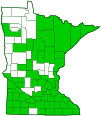Queen Anne’s lace
(Daucus carota ssp. carota)
Conservation • Weed • Wetland • Description • Habitat • Ecology • Use • Distribution • Taxonomy
Description |
Queen Anne’s lace is a 16″ to 60″ tall, erect, biennial forb that rises on a solitary stem from a large, deep, slender, branched taproot. The taproot is woody, not fleshy, and is usually brown. The plant has a carrot scent. In the first year the plant appears as a rosette of basal leaves and closely resembles the typical garden carrot. In the second year it sends up a single flowering stem. Basal leaves are on long stalks (petioles). The petiole is broad and flat at the base. The leaf blades are oblong to triangular egg-shaped in outline, up to 8″ long, and up to 4″ wide. The first leaf is divided into 3 sections (ternate). Subsequent leaves are 2 or 3 times pinnately divided. The ultimate divisions are pinnately lobed. The lobes are linear to lance-shaped, 1 ⁄16″ to ½″ long, and 1 ⁄64″to 1⁄16″ wide. The taper to a short, sharp point at the tip. The upper and lower surfaces are hairy. The margins may be toothed, lobed, or neither (entire). The stem is erect, stout, sparingly branched, finely ridged, round in cross section, and hollow. It is green, rough to the touch, and sparsely to densely covered with stiff, white, spreading to downward pointing hairs. It is not spotted. Stem leaves are alternate. Lower stem leaves are on short petioles. The petioles are broadened at the base. They surround and extend down (sheath) the stem. The upper leaf surface is hairless. The lower leaf surface is sparsely to moderately hairy, especially along the margins and veins. They are smaller but otherwise similar to basal leaves. The leaves become shorter stalked, smaller, and less divided as they ascend the stem. Upper stem leaves are about 2″ long and stalkless or almost stalkless. The inflorescence is a flat-topped, compound, umbrella-shaped cluster (umbel) at the end of the stem and each branch. It is on a 4″ to 21½″ long, moderately to densely hairy stalk (peduncle). The umbel is dense, round, and 2″ to 5″ in diameter. It is subtended by 4 to 15 modified leaves (bracts) that form a loose involucre. The bracts of the involucre are ⅛″ to 1½″ long and are once or twice divided into linear segments (pinnatifid). They are green and hairless or sparsely hairy. The umbel has 20 or more branches (rays) arising from the center of the umbel. The rays are 1 3 ⁄16″ to 3″ long and spreading to ascending. The inner rays are shorter than the outer. At the end of each ray is a secondary umbel (umbellet). Each umbellet is subtended by 5 to 13 bractlets (involucel). The bractlets of the involucel are green and linear. They have broad, thin, white margins, at least near the base. The umbellet has 5 to 20 individual flowers. The central flower is stalkless, the remaining flowers are on 1 ⁄32″ to 5⁄16″ long stalks (raylets). The flowers are about ⅛″ wide. They have 5 petals and no sepals, or sepals that are reduced to minute triangular teeth. The petals are white, inversely egg-shaped, and notched at the tip into 2 lobes of unequal size. The tip of the petal is flexed inward. The outermost petals of the outermost flowers of the outer umbellets are sometimes enlarged. There is often a single dark purple flower at the center of the central umbel. The flowers are not aromatic. As the fruit develops the rays and raylets contract producing an upright, egg-shaped fruiting head that resembles a bird’s nest. The fruit is dry, grayish-brown, ⅛″ to 3 ⁄16″ long, oblong-eliptic to oblong egg-shaped, and flattened laterally. It contains 2 seeds and when ripe splits into 2 one-seeded segments. Each segment (mericarp) has 5 primary ribs and 4 secondary ribs between the primary ribs. The secondary ribs have minutely barbed bristles. Seeds are dispersed by clinging to the fur of passing animals or the clothing of passing hikers. |
Height |
16″ to 60″ |
Flower Color |
White, often with a single dark purple flower in the center. |
Similar Species |
Habitat |
Meadows, old fields, roadsides, and disturbed sites. Full sun to partial shade. |
Ecology |
Flowering |
June to September |
Pests and Diseases |
|
Use |
|
Distribution |
||
|
Sources |
|
| 5/18/2025 | ||
Nativity |
||
Native to North Africa, Asia, and Europe. Introduced and naturalized in North America. |
||
Occurrence |
||
Common |
||
Taxonomy |
|
Kingdom |
|
Division |
Tracheophyta (Vascular Plants) |
Subdivision |
Spermatophytina (Seed Plants) |
Class |
|
Order |
Apiales (Carrots, Ivies, and Allies) |
Suborder |
Apiineae |
Family |
Apiaceae (carrot) |
Subfamily |
Apioideae |
Tribe |
Scandiceae (chervils, carrots, hedgeparsleys and allies) |
Subtribe |
Daucinae |
Genus |
Daucus (Carrot) |
Subgenus |
Daucus |
Species |
Daucus carota (Queen Anne’s lace) |
Subordinate Taxa |
|
|
|
Synonyms |
|
Carota sylvestris Caucalis carnosa Caucalis carota Caucalis daucus Daucus abyssinicus Daucus agrestis Daucus alatus Daucus allionii Daucus australis Daucus bactrianus Daucus blanchei Daucus brevicaulis Daucus carota ssp. dentatus Daucus carota ssp. hispidus Daucus carota ssp. sylvestris Daucus carota var. abyssinicus Daucus carota var. acaulis Daucus carota var. agrestis Daucus carota var. alba Daucus carota var. atrorubens Daucus carota var. aurantia Daucus carota var. brachycentrus Daucus carota var. carnosus Daucus carota var. excelsus Daucus carota var. exiguus Daucus carota var. foliosus Daucus carota var. glaber Daucus carota var. glaber Daucus carota var. hispidus Daucus carota var. nanus Daucus carota var. pseudocarota Daucus carota var. sylvestris Daucus carota var. timbalianus Daucus carota var. valentinus Daucus carota var. violaceus Daucus communis Daucus communis ssp. carota Daucus communis var. agrestis Daucus communis var. allionii Daucus communis var. marcidus Daucus communis var. prostratus Daucus communis var. pseudocarota Daucus communis var. timbalianus Daucus dentatus Daucus exarmatus Daucus exiguus Daucus fernandezii Daucus foliosus Daucus gaditanus Daucus gibbosus Daucus gingidium Daucus heterophylus Daucus kotovii Daucus levis Daucus marcidus Daucus maritimus Daucus martellii Daucus montanus Daucus nudicaulis Daucus officinalis Daucus polygamus Daucus scariosus Daucus sciadophylus Daucus strigosus Daucus sylvestris Daucus vulgaris Daucus vulgaris var. atrorubens Daucus vulgaris var. flavus Daucus vulgaris var. polygamus Platyspermum alatum |
|
Common Names |
|
bird’s nest bird’s-nest devil’s-plague Queen Anne’s-lace Queen Anne’s lace queen’s-lace salosi wild carrot |
|
Glossary
Bract
Modified leaf at the base of a flower stalk, flower cluster, or inflorescence.
Bractlet
A small, often secondary bract within an inflorescence; a bract that is borne on a petiole instead of subtending it; bracteole.
Involucel
A whorl of bractlets beneath a secondary flower cluster in a compound inflorescence.
Involucre
A whorl of bracts beneath or surrounding a flower, flower head, or flower cluster.
Linear
Long, straight, and narrow, with more or less parallel sides, like a blade of grass.
Mericarp
The split, usually one-seeded portion of a dry, multi-seeded fruit.
Peduncle
In angiosperms, the stalk of a single flower or a flower cluster; in club mosses, the stalk of a strobilus or a group of strobili.
Pinnatifid
Deeply cut, more than half way to the midrib but not to the midrib, into lobes that are spaced out along the midrib; the lobes do not form separate leaflets.
Ray
In the Asteraceae (aster) family: a strap-shaped flower, or the strap-shaped portion of a flower. In the Apiaceae (carrot) and Euphorbiaceae (spurge) families: a branch of an umbel.
Raylet
A branch of an umbellet.
Sheath
The lower part of the leaf that surrounds the stem.
Ternate
Refers to leaves that are divided into three leaflets or sections.
Umbel
A flat-topped or convex, umbrella-shaped cluster of flowers or buds arising from more or less a single point.
Umbellet
A secondary umbel in a compound umbel.
Visitor Photos |
||
Share your photo of this plant. |
||
This button not working for you? |
||
Alfredo Colon |
||
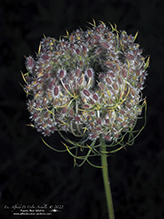 |
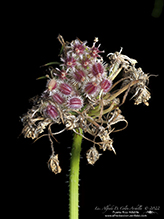 |
|
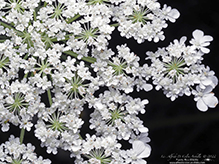 |
 |
|
 |
||
Robert Briggs |
||
Queen Anne's Lace pictures taken today in Pine Bend Bluffs SNA. |
||
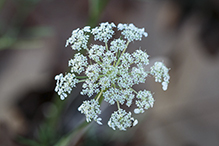 |
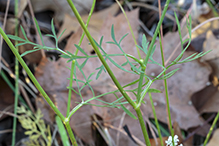 |
|
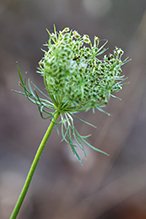 |
||
MinnesotaSeasons.com Photos |
||
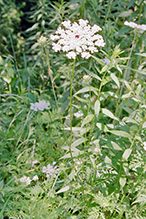 |
 |
|
Plant |
Inflorescence |
|
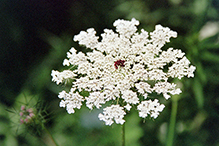 |
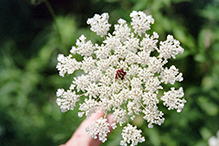 |
|
Inflorescence |
Inflorescence |
|
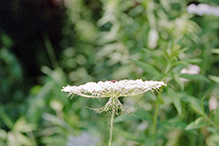 |
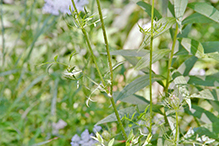 |
|
Inflorescence |
Leaves |

Slideshows |
Wild Carrot |
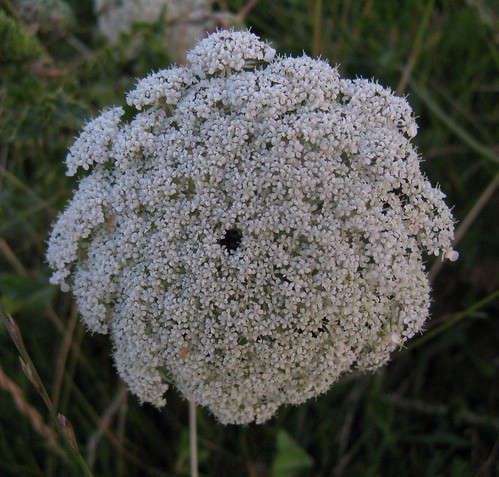
|
About
Wild Carrot (Daucus carota). |
Queen Annes Lace |
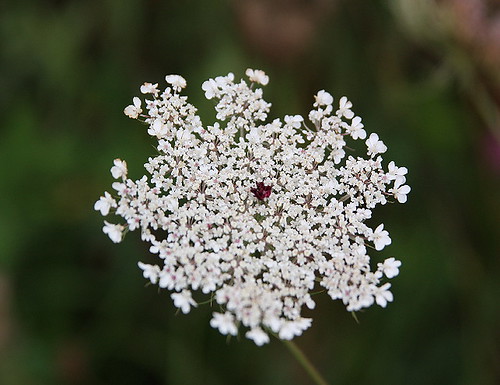
|
About
Copyright DianesDigitals |
Queen Anne's Lace (Daucus carota) |
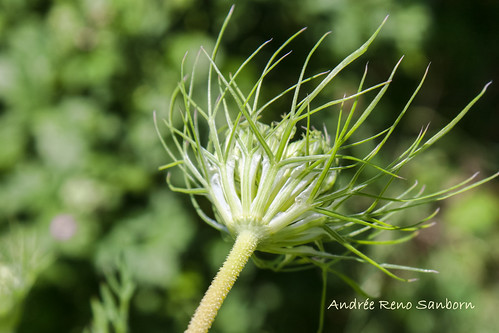
|
Daucus carota QUEEN ANNE'S LACE |

|
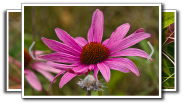
Visitor Videos |
||
Share your video of this plant. |
||
This button not working for you? |
||
|
Other Videos |
||
Wild carrot Daucus carota time lapse |
About
Published on Nov 21, 2013 Wild carrot, Daucus carota subsp carota flowers opening time lapse. Filmed by Neil Bromhall www.rightplants4me.co.uk This is a beautiful wildflower. The flowers are white, in many small, simple umbels, making a large, flat-topped compound umbel. In the middle of the umbel is a single red flower Fruits are 2-4mm, flattened, often with hooked bristles. Bees and insects love this flower. Music 'Moon Cloud' by Paul Mottram |
Wild Carrot (Daucus Carota) - 2012-07-02 |
About
Published on Jul 4, 2012 Daucus carota (common names include wild carrot, (UK) bird's nest, bishop's lace, and (US) Queen Anne's lace) is a flowering plant in the family Apiaceae. ----------------- |
Daucus carota |
About
Published on Jun 8, 2014 Wild Carrot , Queen Anne's Lace - a well established introduction fro Eurasia used in plantings as a groundcover but also a quite invasive biennial plant up to 120 cm tall. |

Visitor Sightings |
||
Report a sighting of this plant. |
||
This button not working for you? |
||
| Alfredo Colon 8/15/2022 |
Location: Albany, NY |
 |
| Alfredo Colon 8/2/2022 |
Location: Albany, NY |
 |
| Alfredo Colon 9/3 to 9/5/2019 |
Location: Woodbury, Minnesota |
 |
| Robert Briggs 11/9/2016 |
Location: Pine Bend Bluffs SNA Queen Anne's Lace pictures taken today in Pine Bend Bluffs SNA. |
 |
MinnesotaSeasons.com Sightings |
||
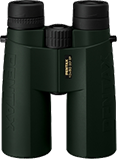
|
Created: 8/2/2008 Last Updated: © MinnesotaSeasons.com. All rights reserved. |
